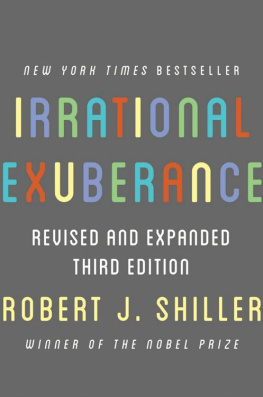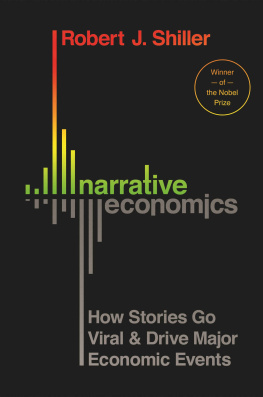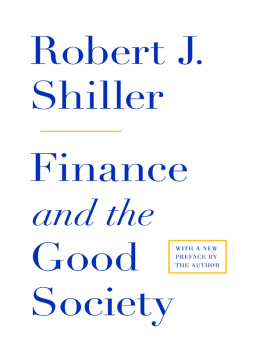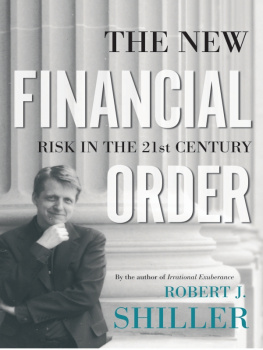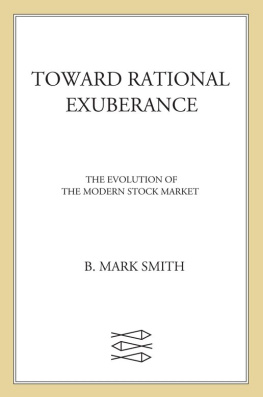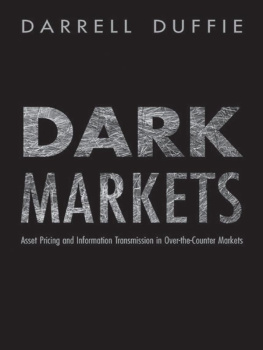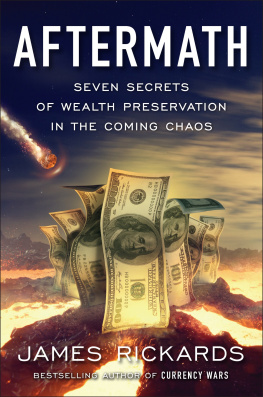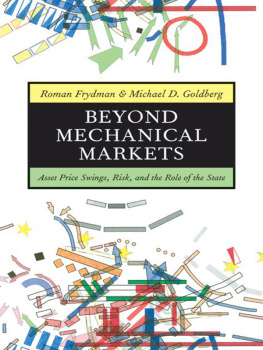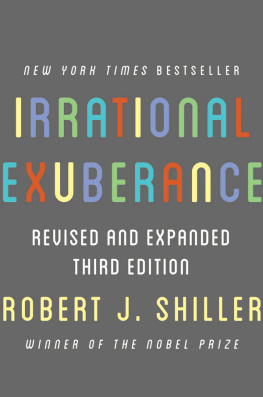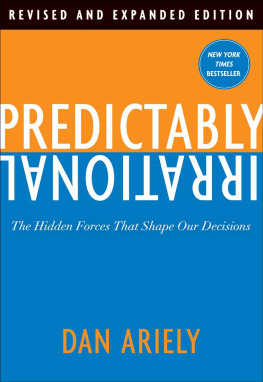Irrational Exuberance
Irrational Exuberance
REVISED AND EXPANDED THIRD EDITION
________________________
Robert J. Shiller
Princeton University Press
Princeton and Oxford
Disclosure: In addition to being a professor at Yale University, the author is currently working part-time with Standard & Poors to produce home price indices; with the Chicago Mercantile Exchange, which maintains a futures market for the S&P/Case-Shiller Home Price Indices, as part of the Competitive Markets Advisory Council at the CME Group; and with Barclays Bank and its affiliates in producing various investment products. Nothing in this book constitutes, or should be construed as, either an offer to sell or a solicitation of an offer to purchase any securities, including any securities that may at any time be offered for sale or sold by any of the above-named persons. In the United States, offers to sell and solicitations of offers to buy any securities may be made only by a prospectus (as defined in the Securities Act of 1933, as amended) delivered to the prospective purchasers. Similar regulations apply in other countries. This book contains various forward-looking statements based on the authors projections, hypotheses, forecasts, estimates, beliefs, and prognoses about future events. All forward-looking statements contained herein reflect solely the authors opinions about such future events and are subject to significant uncertainty. Actual events may differ materially from those described in such forward-looking statements.
Copyright 2015 Robert J. Shiller
Nobel lecture copyright 2013 The Nobel Foundation
Published by Princeton University Press, 41 William Street, Princeton, New Jersey 08540
In the United Kingdom: Princeton University Press, 6 Oxford Street, Woodstock, Oxfordshire OX20 1TW
press.princeton.edu
Jacket design by Steve Attardo / NINETYNORTH
All Rights Reserved
Library of Congress Cataloging-in-Publication Data
Shiller, Robert J.
Irrational exuberance / Robert J. Shiller.Revised and expanded third edition.
pages cm
Includes bibliographical references and index.
ISBN 978-0-691-16626-1 (hardcover : alk. paper)
1. StocksUnited States. 2. Stock exchangesUnited States. 3. StocksPricesUnited States. 4. Real propertyPricesUnited States. 5. Risk. 6. Dow Jones industrial average. I. Title.
HG4910.S457 2015
332.632220973dc23
2014036705
This book has been composed in Adobe Palatino and Berkeley Old Style Book and Black by Princeton Editorial Associates Inc., Scottsdale, Arizona
Printed on acid-free paper.
Printed in the United States of America
10 9 8 7 6 5 4 3 2 1
To Ben and Derek
Contents
Part One
Structural Factors |
Part Two
Cultural Factors |
Part Three
Psychological Factors |
Part Four
Attempts to Rationalize Exuberance |
Part Five
A Call to Action |
Figures and Tables
Preface to the Third Edition
O ne might think that years after the bursting of the speculative bubbles that led to the 20079 world financial crisis, we should be living in a distinctly different post-bubble world. One might think people would have learned their lesson and would not again pile into expanding markets, as so many did before the crisis, thereby worsening incipient bubbles. But evidence of bubbles has accelerated since the crisis. Valuations in the stock and bond markets have reached high levels in the United States and some other countries, and valuations in the housing market have been increasing rapidly in many countries. All this has been occurring despite a disappointing world recovery from the financial crisis, an increasingly tense international situationwith deadly wars in Gaza, Iraq, Israel, Syria, and Ukraineand a wave of potentially disruptive nationalist sentiment and political polarization in the United States, Europe, and Asia.
As of this writing, the International Monetary Fund has just put out a warning of overheated housing markets in Asia, Europe, Latin America, and in Australia, Canada, and Israel.
The bubbly and apparently unstable situation warrants some concern, although not yet generally as extreme as when the first edition of this book issued a warning about the overpriced and vulnerable stock market (see the reprinted 2000 Preface below), or when the second edition of this book issued a warning about the overpriced and vulnerable housing market as well (see the reprinted 2005 Preface below).
By the time this book finds its way into the hands of readers, the markets may be in a very different situation. Markets can change very rapidly, and the optimistic pricing we see at the time of this writing (in October 2014) is hard to predict. Current pricing may not last long when compared with publication lag and the time needed for an issue to become part of readers agendas. But I am writing for future readers, years hence, who will read about the markets in the midsecond decade of the twenty-first century as just one of many examples described in the bookexamples of broader tendencies and uncertainties.
Hence, the themes of the first edition of this book, with some updating, remain relevant today and probably always will be relevant. When the first edition of this book came out in 2000, I took pains to assert that the stock market bubble of that time, while exceptionally large, was really nothing fundamentally new. in this edition, New Eras and Bubbles around the World, details how many times we have had similar, if smaller or more localized, stock market booms and crashes. There was something relatively new then: the stock market boom that we now know peaked in early 2000 was worldwide in scope. In the first edition, I called it the Millennium Boom, because it came just before the dawn of the new millennium. We might also confidently call it the Millennium Bubble now, after it is over. But this boom or bubble was not really bigger in its collapse than its counterpart, which peaked in 1929. These really large bubbles are rare events, but the Millennium Bubble was not unique in history.
In the second edition (2005), I made much of the fact that for the United States as a whole, the boom in home prices nationwide that had begun in the late 1990s was the biggest ever, or biggest at least since 1890, when my data began. But, at the same time, the new chapter that was added to that edition also recounted earlier housing bubbles, and, if you look at centuries past, land price bubbles. Centuries ago, real estate speculation would have been more likely an investment in landa farm or a town lot for building a home. Another big change in the second half of the twentieth century was a massive decline in lending standards for home mortgages. That decline, and the magnitude of the housing boom around the world (which we might now, after the collapse of home prices in many areas after 2006, confidently call a bubble) was unique. We might call this the Ownership-Society Boom, associated as it was with a slogan used by George W. Bush in his 2004 U.S. presidential campaign to describe his plan to promote widespread ownership of homes, stocks, and other investments. (I will call the current stock market boom, from 2009 to the time of this writing in 2014, the New-Normal Boom, after a term popularized by Bill Gross [then of PIMCO] in 2009.)
But there is really nothing new about these bubblesnot fundamentally new. They are repeats of approximately the same phenomenon, of new era stories proliferating by word-of-mouth contagion, of the distinct feel of mass enthusiasm for one kind of investment.

